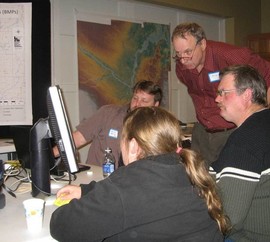
It’s not often you think of fishing and farming as being in the same boat. Unless you know about the Fishers and Farmers Partnership. Organized about 10 years ago, according to its website, it’s “a self-directed group of non-government organizations, tribal organizations, and state and federal agencies united to add value to farms while protecting, restoring, and enhancing the 30,700 miles of rivers and streams of the Upper Mississippi River Basin. We work for flexible, collaborative relationships between landowners, agriculture, and conservation organizations to empower landowners to act for themselves and the greater good.”
Since 2009 Minnesota has been represented on the group’s steering committee by Steve Sodeman and Jack Lauer. Steve is a farmer, crop consultant, and former Minnesota Corn Growers Association director; Jack is with DNR fisheries in New UIm. The partnership has helped fund several projects in Minnesota over the past 10 years, such as Rice Creek and 7-Mile Creek. Last fall, eight farmers planted cover crops on about 800 acres of land in the Rice Creek watershed just west of Dundas in southeast Minnesota. In 7-Mile Creek, a tributary of the Minnesota River north of Mankato, they have worked with farmers to complete 65 conservation best management practices, and planted more than 100 marginal acres to perennial vegetation. Several farmers are incorporating conservation drainage, strip and no till, and cover crops. It also helps support the LeSueur River Watershed Network. A Fishers and Farmers field day is in the plans for Sept. 16 at a location to be determined in southeast Minnesota. Photo: LeSueur River Watershed Network meeting.
|

The Minnesota Agricultural Water Resource Center (MAWRC) membership met on April 5, holding a listening session with agency leadership in the morning, followed by a short business meeting. MDA Commissioner Thom Petersen, DNR Commissioner Sarah Strommen, MPCA Deputy Commissioner Peter Tester and BWSR Executive Director John Jaschke gave overviews of their agency’s work. Topics ranged from the nitrogen rule and Southeast Minnesota GEIS on nitrates to grazing on public land and buffer compliance.
The business meeting provided an update on the recent changes in the MAWRC by-laws and elections to the board of directors. Glen Graff, Karlen Nelson and Michael White were elected to the board, joining Tim Velde, Doug Albin, Bob Roelofs and Kurt Krueger. The new structure is designed to allow the smaller board to meet regularly for governance purposes and more frequent membership meetings to address specific needs on a sector or regional basis. The board of directors held a brief meeting following the annual meeting to elect officers. Tim Veld was re-elected Chair, Michael White was elected Vice-chair, Bob Roelofs was elected Secretary and Doug Albin was elected Treasurer. – Minnesota Milk Minute newsletter
|

Memorial Day Weekend marked the unofficial kick-off to the locally grown summer food season. On May 24 the MN Agricultural Water Quality Certification Program and Minnesota Grown came together at the Food Farm in Wrenshall to celebrate Minnesota’s locally grown food.
Local foods are a popular trend with consumers, and they are continuing to shift toward companies and products that have an environmental focus. According to Neilsen, 68% of Americans say it's extremely or very important that companies implement programs to improve the environment, and 48% say they’ll change their own consumption habits to reduce their environmental impact (Neilsen Total Cosumer Report: December 2018).
New this year, consumers can find Ag Water Quality Certified farms in the Minnesota Grown Directory. These farms are scattered across the state, from Bemidji to Zumbrota, including the Food Farm in Wrenshall.
|
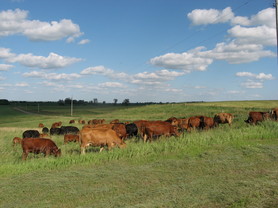
Once again the Soil Health Academy will be conducting an intensive three-day workshop Aug. 13-15 at the Grant and Dawn Breitkreutz' Stoney Creek Farm (photo) west of Redwood Falls. It will examine all aspects of regenerative farming and ranching, soil health, plant health, and animal health. Hands-on experience will be emphasized.
Taught by highly experienced and regenerative farmers, participants will work in teams to solve real-world grazing problems and sharpen their skills. Topics will include: Principles of soil health and adaptive stewardship, restoring vibrant ecosystems through adaptive grazing, making grazing highly profitable and desirable, successful marketing, strategies for enhanced net margins, nutrient management, designing cover crop mixes, farm economics and whole farm planning.
"We are very proud to have found our way to improving soil health," says Grant. "We see the increased wildlife, biological life in the soil, improved grain yields, and the improved health of our livestock. We have eliminated erosion and improved water infiltration, which means we now keep the water where it's supposed to be. What could be better than that?" For more information and to register online.
|
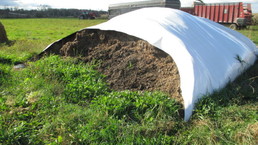
The MPCA feedlot program reminds livestock producers that temporary feed stockpiles should meet run-off control requirements similar to permanent stockpile sites. Notably among dairies, temporary silage stockpiles are being seen in locations with potential for runoff to impact waters. Runoff from feed storage areas can impact water by lowering the oxygen supply in the water. Temporary stockpiles at sites with a NPDES or SDS permit should be located where stormwater runoff can be contained. Temporary stockpiles at other sites should use Best Management Practices including sufficient vegetated buffer area, an impermeable pad such as concrete or asphalt, or using plastic “ag bags.” For more information see the factsheet, “Feed storage areas at animal feedlots” on the MPCA feedlot program Construction, operation, and technical requirements web page.
|
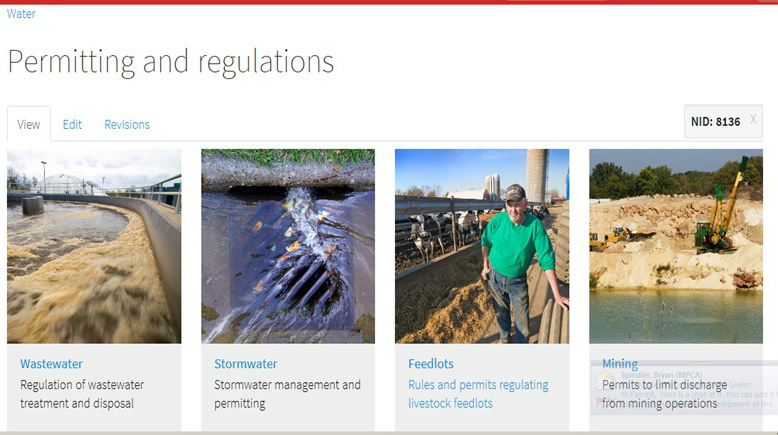
In an effort to streamline the MPCA website, there will be a change in navigation to the Feedlot Program landing page. On the MPCA home page, from the menu across the top of the page, click on Water. On the drop-down menu click on Permitting and Regulations. Among the eight choices on that page, a link to the Feedlot Program is in the top row second from right. Typing 'feedlot' in the Search box also puts the Feedlot Program link at the top of the list. The Feedlot Program link will no longer be available from Quick Links on the menu bar on the home page. The direct URL is www.pca.state.mn.us/feedlots. If you have comments or suggestions about the MPCA Feedlot Program web pages, contact Forrest Peterson, 320-979-1776, forrest.peterson@state.mn.us.
|
The North American Manure Expo (NAME) has released a Request for Proposals for mini-grants and seed funding for up to four awards, each not to exceed $2,000, to support educational programming or research projects that will directly benefit manure applicators or farmers applying manure. Working directly with manure applicators and collaboration between institutions (university, industry, applicators, and across state lines) is encouraged. Proposals should be received by Friday, June 28, 2019. See the RFP for more information.
The North American Manure Expo is a non-profit organization that formed in 2013. The board consists of members of Professional Nutrient Applicators Association of Wisconsin (PNAAW) and at least one professional hauler from another state, industry company representatives, various national level extension professionals, and a member of the Ag Annex Publishing group. The board oversees a large annual event that brings manure haulers across the U.S. and Canada (as well as a few others) together to advance the manure industry. The 2019 Expo is July 31-Aug. 1 at Fair Oaks, IN.
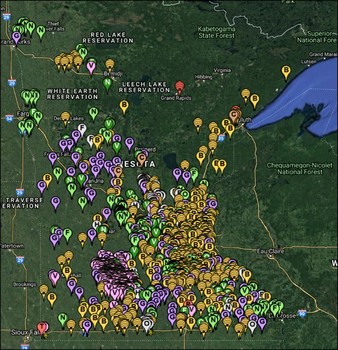
DriftWatch (and BeeCheck) are free, voluntary online registries that that allow specialty crop producers to communicate the location of their pesticide-sensitive sites to pesticide applicators. Applicators can then take precautions to avoid injury due to spray drift. Specialty crops include fruits, vegetables, and organic produce. (BeeCheck is a version of DriftWatch for beekeepers, who do not also have other specialty crops.)
This communication is done by indicating the location of the sensitive sites on an online map. DriftWatch is Google Maps™ based and is fairly easy to use. The map symbol indicates the crop in that field. View the current map of registered sensitive sites in Minnesota.
For detailed instructions on using DriftWatch, see: User Guide: How to Register Your Crops and Beehives in FieldWatch. There is also a “How to” videos for registering sites on DriftWatch and BeeCheck.
|
Growing ‘climate smart farming’ movement hopes to combat climate change, CBS News, 5/7/19
Novel crops can save rural Minnesota's drinking water, U says, Star Tribune, 5/28/19
DNR releases Minnesota’s National Wetlands Inventory update, 6/3/19
June 12-13: Minnesota Milk Producers-Summer Escape, Spicer.
July 9: Summer Beef Tour, Morris.
July 10-11: Midwest Farm Energy Conference, U of M-Morris.
Aug. 1: Partners in Ag Innovation, MinnWest Technology Campus, Willmar.
Aug. 6-8: Farm Fest, Gilfillan farm, Redwood County.
Aug. 13-15: Soil health academy, Breitkreutz farm, Redwood County.
Sept. 16: Fishers and Farmers field day, details TBA.
Dec. 17-18: Conservation Tillage Conference, St. Cloud
The
MPCA Feedlot Update welcomes news from partners about, projects, people, and
upcoming events. Email submissions to forrest.peterson@state.mn.us.
Past issues of Feedlot Update are available on the feedlot program publications webpage.
|